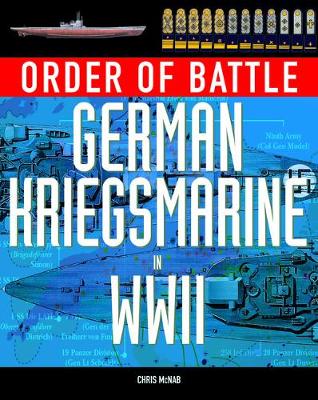Order of Battle
2 total works
Germany’s air force, the Luftwaffe, played a critical role in the Third Reich’s victories in the early part of World War II, providing the airborne component of the German forces’ irresistible Blitzkrieg (`lightning war’) tactics that swept all armies before it from 1939 to 1942.
Broken down by campaign and key battles within each theatre of war, Order of Battle: German Luftwaffe in World War II illustrates the strengths and organizational structures of the Third Reich’s air force, building into a detailed compendium of information. Full-colour order of battle tree diagrams at Luftflotten, Gruppe, Fliegerkorps and squadron level help the reader quickly understand how and where bomber (Kampfgeschwader), fighter (Jagdgeschwader), divebomber (Stukageschwader) and reconnaissance (Aufklärungsgruppe) units were employed. Quick reference tables provide unit strengths, aircraft types and base locations, while profile diagrams show typical numbers of aircraft at squadron level.
With extensive organizational diagrams, tables and full-colour campaign maps, Order of Battle: German Luftwaffe in World War II is an attractive, easy-to-use guide to the German air force of World War II. The book is an essential reference for any serious enthusiast of air warfare in the twentieth century.
Broken down by campaign and key battles within each theatre of war, Order of Battle: German Luftwaffe in World War II illustrates the strengths and organizational structures of the Third Reich’s air force, building into a detailed compendium of information. Full-colour order of battle tree diagrams at Luftflotten, Gruppe, Fliegerkorps and squadron level help the reader quickly understand how and where bomber (Kampfgeschwader), fighter (Jagdgeschwader), divebomber (Stukageschwader) and reconnaissance (Aufklärungsgruppe) units were employed. Quick reference tables provide unit strengths, aircraft types and base locations, while profile diagrams show typical numbers of aircraft at squadron level.
With extensive organizational diagrams, tables and full-colour campaign maps, Order of Battle: German Luftwaffe in World War II is an attractive, easy-to-use guide to the German air force of World War II. The book is an essential reference for any serious enthusiast of air warfare in the twentieth century.
Germany’s navy, the Kriegsmarine, played a critical role in the Third Reich’s attempt to restrict the flow of supplies, men and materiel from the United States to Britain in the early years of the war and from North America and Britain to the Soviet Union from 1941. Such was the success of the U-boats in particular, by the end of the war more than 3000 Allied ships with a combined gross tonnage 14.5 million had been sent to the bottom of the sea.
Broken down by campaign and key actions, Order of Battle: German Kriegsmarine in World War II illustrates the strengths and organizational structures of the Third Reich’s navy, building into a detailed compendium of information. Full-colour order of battle tree diagrams help the reader quickly understand the make up of U-boat flotillas and surface fleets. Examples from key moments in the war include the U-boat wolfpack group West, which harried Allied shipping in the summer of 1941 and the fleet gathered for the invasion of Denmark in April 1940.
With extensive organizational diagrams, tables and full-colour maps, Order of Battle: German Kriegsmarine in World War II is an attractive, easy-to-use guide to the German navy of World War II. The book is an essential reference for any serious enthusiast of naval warfare in the twentieth century.
Broken down by campaign and key actions, Order of Battle: German Kriegsmarine in World War II illustrates the strengths and organizational structures of the Third Reich’s navy, building into a detailed compendium of information. Full-colour order of battle tree diagrams help the reader quickly understand the make up of U-boat flotillas and surface fleets. Examples from key moments in the war include the U-boat wolfpack group West, which harried Allied shipping in the summer of 1941 and the fleet gathered for the invasion of Denmark in April 1940.
With extensive organizational diagrams, tables and full-colour maps, Order of Battle: German Kriegsmarine in World War II is an attractive, easy-to-use guide to the German navy of World War II. The book is an essential reference for any serious enthusiast of naval warfare in the twentieth century.

